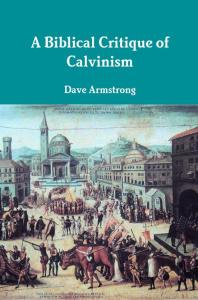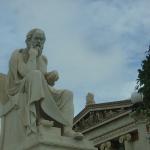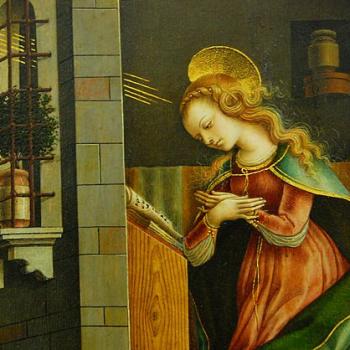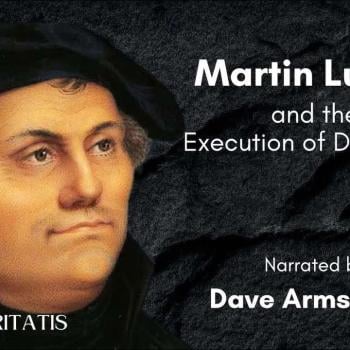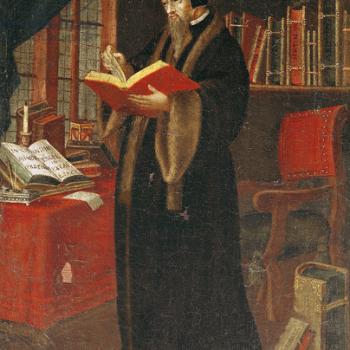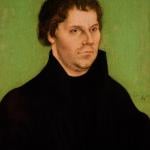[see book and purchase information]
Lucas Banzoli is a very active Brazilian anti-Catholic polemicist, who holds to basically a Seventh-Day Adventist theology, whereby there is no such thing as a soul that consciously exists outside of a body, and no hell (soul sleep and annihilationism). This leads him to a Christology which is deficient and heterodox in terms of Christ’s human nature after His death. He has a Master’s degree in theology, a degree and postgraduate work in history, a license in letters, and is a history teacher, author of 25 books, as well as blogmaster (but now inactive) for six blogs. He’s active on YouTube.
This is my 27th refutation of articles written by Lucas Banzoli. As of yet, I haven’t received a single word in reply to any of them (or if Banzoli has replied to anything, anywhere, he certainly hasn’t informed me of it). Readers may decide for themselves why that is the case. I use RSV for the Bible passages unless otherwise indicated. Google Translate is utilized to render Lucas’ Portugese into English. His words will be in blue.
*****
I’m replying to Lucas’ article, “Breve refutação a dez calúnias católicas sobre a Reforma” [Brief refutation of ten Catholic slanders about the Reformation] (8-19-17).
I am writing a book on the Protestant Reformation, which I intend to have ready by the 500th anniversary of the Reformation on October 31st.
Yes; I like anniversaries, too. I prepared 55 refutations of John Calvin on the occasion of the 500th anniversary of his birth (2009), including a complete reply to Book IV of his Institutes of the Christian Religion. I have more such material in my books, Biblical Catholic Answers for John Calvin (March 2010, 388 pages), and A Biblical Critique of Calvinism (Oct. 2012, 178 pages). I’m sure he was smiling from purgatory when he found out about those “birthday gifts.” If he made it to heaven, we’ll play a few chess games and I’ll assure him it was nothing personal: simply a old-fashioned, “quaint” concern about truth and accuracy.
I was busy on the 500th anniversary of the Protestant Revolution, too, and put out two appropriate new articles and a revision:
Critique of Ten Exaggerated Claims of the “Reformation” [10-31-17]
Catholic Church vs. the Bible? Exchange w Protestant [10-31-17]
Luther on the Deaths of Zwingli, St. Thomas More, & St. John Fisher [11-30-07; expanded on 10-31-17]
I also had some fun on the next day:
To that end, I have been reading as many books as possible on the subject for months, as I intend it to have at least one hundred bibliographic references, which is the minimum required in any serious academic work in history (this is the main reason why I have updated the blog so little lately).
I would have never suspected that, given the uniformly low quality of this article. I can see it if he was simply reading ultra-biased, bigoted anti-Catholic tripe of little scholarly value.
Here I will not argue extensively upon every point that uneducated Papists blatantly distort and lie about: which I will leave to do in depth in the book, with specific chapters referring to each issue below and many others.
Lucky for him, because I would have systematically dismantled it, just as I am going to do with his pathetic existing material now.
In this article I will only give a summary of the rebuttals to each Romanist slander or slander on the history of the Reformation, as many people have asked me to write a brief and to the point explanation of these matters. This article will be the answer to those questions.
I understand the inherent limitations of brief treatments; nevertheless, they ought not contain blatant falsehoods: a thing this article is chock-full of.
Enjoy reading, as this will probably be the only text written by someone who has actually read and studied these topics in depth, instead of just copying and pasting from other sites, as they only know how to do.
Most of my replies, as the reader will soon find out, come from exhaustive existing research of my own. If Lucas thinks my research is shoddy, too, then let him refute it. Unfortunately, he chose not to make any reply whatsoever to my previous 26 installments. I’ll be careful not to hold my breath waiting for him answer to this, because I like being alive.
Slander 1: There was a “Protestant Inquisition”, which killed more than the Catholic Inquisition.
Answer: “Protestant Inquisition” is a term that is completely absent in history books written by reputable historians or in serious academic publications.
This is untrue (on all four counts), and it took me about three minutes to discover that in a search. It turned up in a 362-page scholarly book that I have in my own library: Inquisition, by Edward Peters (University of California Press, Apr 14, 1989). It contains this excerpt:
The execution of Michael Servetus became the symbol of the dangers of a “Protestant Inquisition” and was used by many supporters of religious toleration as a counterpoint to the Spanish Inquisition. (text for Plate 14 [painting of Servetus]: between pages 218 and 219)
Dr. Peters was a professor of medieval history at the University of Pennsylvania and author of seven more related books about the Middle Ages and religious toleration (or lack thereof).
A bit of friendly advice to Lucas, so he won’t further embarrass himself: try not to ever make “universal negative” statements. They will come back to “bite” and haunt you every time. At least qualify it if you insist on making a sweeping claim.
Another irony is that it is fairly well-known to students of Calvin’s history (I’ve known it for over thirty years), that he was willing at one point to deliver Servetus up to the Catholic inquisition. How ironic, huh? Here is a reference to that in a Protestant source:
Calvin and Servetus corresponded for a time before the former gave up in frustration. He warned that if Servetus came to visit him in Geneva, ‘I would not let him leave alive’.
He wasn’t exaggerating. Calvin informed the Catholic Inquisition of Servetus location – they decreed that he be burned, though the lucky heretic escaped his capture. He was caught out when he came to Geneva however, where he was spotted and the local council had him arrested and sentenced to death. To give some credit to Calvin, he encouraged Servetus to repent, with no success. He also unsuccessfully lobbied for some (relative) leniency for the prisoner, suggesting beheading instead of being burned alive.
But various correspondence shows that even though Calvin didn’t sentence Servetus, he still believed it was right for him to die for his heresy. As for those who criticised his enthusiasm for Servetus’ death, Calvin revelled in their opposition – and said they were just as guilty as the heretics.
One contemporary of Calvin’s, Sebastian Castellio, said that his hands were ‘dripping with the blood of Servetus’. Even though Servetus would have probably faced death without Calvin’s help, it’s not an unfair assessment. (“The dark side of the Reformation: John Calvin and the burning of heretics”, Joseph Hartropp, Christian Today, two typos corrected)
Lucas later admits in this article:
We are not justifying the execution of Servetus, which was arguably a black and extremely regrettable stain on the history of the Reformation.
This myth was recently invented by American Catholic apologetics blogs in an attempt to assuage the Catholic Inquisition (ie, the one that existed), and “imported” by Brazilian Catholic apologetics.
Actually, I myself probably came up with the term that has circulated online, in the first draft of my book, A Biblical Defense of Catholicism: this portion completed on 3 June 1991 (portions of which would turn up online after 1996). One of my original book chapters (later discarded for a shorter book and only used online) was called “The Protestant Inquisition (‘Reformation’ Intolerance and Persecution).” Follow the link to see an archived version of the chapter, dated 17 August 2000. And of course it includes a ton of information precisely about what the title alludes to. As to the supposed “myth” of Protestant persecution, I cited well-known secularist historian Will Durant, who stated:
The principle which the Reformation had upheld in the youth of its rebellion — the right of private judgment — was as completely rejected by the Protestant leaders as by the Catholics . . . Toleration was now definitely less after the Reformation than before it. (The Reformation, [vol. 6 of 10-volume The Story of Civilization, 1967], New York: Simon & Schuster, 1957, p. 456. He was referring to the year 1555, the time of the Diet of Augsburg)
Why did I use this term? It was “turning the tables” on Protestant anti-Catholic polemicists who pretended that Protestant persecution either didn’t exist, or was far less than Catholic persecution. That is the myth here. All religious groups persecuted, as soon as they had the power to do so. And they did because it was believed that heresy was more harmful to a soul than even murder was to a body. And it had some rationale: particularly in the Old Testament, where capital punishment was used for many crimes and violations of the Mosaic Law.
I used the term in order to be provocative and to “tweak” the Protestant into understanding that there are two sides to every story, and that Protestants don’t come out totally clean on this score, either. I would prefer to let the past alone about all this, but because Protestants insist on either willful ignorance or a blatant double standard (i.e., only talking about Catholic persecution and intolerance), I document their own sordid past in this respect, too. Lucas seems intent on playing the same self-deluded game. Readers of his will be thoroughly disabused of it if they read this reply.
Lucas stated later in this article:
While hundreds of thousands of people were murdered in a variety of ways in Catholic countries purely for religious reasons, only one was in a Protestant country – and one that wasn’t even Catholic.
This is sheer nonsense: that only Servetus was a victim of Protestant intolerance. There were tens of thousands, as I substantiate immediately below:
Type “Protestant Inquisition” into any search engine and you will only find Catholic blogs . . .
That’s not what I found. I found the above reference. I have had to spend time refuting ultra-ridiculous claims, such as in this article of mine: Catholic Inquisition Murdered “50-68 Million”? [5-23-17]: that lame-brained anti-Catholic Protestant ignoramuses crank out. On page 87 of his book, Peters states:
The best estimate is that around 3000 death sentences were carried out in Spain by Inquisitorial verdict between 1550 and 1800, a far smaller number than that in comparable secular courts.
Henry Kamen, a Fellow of the Royal Historical Society and professor of history at various universities, including the University of Wisconsin – Madison; author of The Spanish Inquisition: A Historical Revision (London and New Haven: Yale University Press, 1998; fourth revised edition, 2014), gave his professional opinion as to these estimated numbers:
Taking into account all the tribunals of Spain up to about 1530, it is unlikely that more than two thousand people were executed for heresy by the Inquisition. (p. 60)
[I]t is clear that for most of its existence that Inquisition was far from being a juggernaut of death either in intention or in capability. . . . it would seem that during the sixteenth and seventeenth centuries fewer than three people a year were executed in the whole of the Spanish monarchy from Sicily to Peru, certainly a lower rate than in any provincial court of justice in Spain or anywhere else in Europe. (p. 203)
For copiously documented facts and figures, see: “Beyond the Myth of The Inquisition: Ours Is ‘The Golden Age’”, by Fr. Brian Van Hove, S. J., Faith and Reason (Winter, 1992).
But Lucas made the following absurd statement in another paper of his: “Catholic apologists, . . . when they speak of the Inquisition, usually only mention the death toll taken out of their heads” (Brief rebuttal to five tactics of Catholic revisionists on the Inquisition, 8-30-17).
They are not able to cite a single book other than Catholic proselytizing that defends this concept. Speak of “Protestant Inquisition” in an academic setting and you will be completely laughed at. In short, the infamous “Protestant Inquisition” is completely unknown to historians, although ubiquitous on Catholic blogs.
See Inquisition by a medieval scholar above. The “last laugh” is on Lucas. But even if I couldn’t have found the term, I certainly have found the tactics and the intolerance that the term represents. And that’s the whole point. I have massively documented Protestant intolerance (with an entire web page devoted to it).
As if the creation of the myth of the “Protestant Inquisition” were not enough, they still invented another one: that this Inquisition “killed more than the Catholic”!
That may have been the case, seeing that England was the most powerful Protestant country, and (14 years ago) I documented at least 1375 Catholic martyrs by name:
430 Catholic Martyrs Murdered by Henry VIII (1534-1544) [2-6-08]
312 Catholic Martyrs & Confessors Under “Good Queen Bess” (Queen Elizabeth: r. 1558-1603) [2-8-08]
189 English Catholic Martyrs & Heroic Confessors: 1603-1729 [2-16-08]
444 Irish Catholic Martyrs and Heroic Confessors: 1565-1713 [2-27-08]
Secondly, it’s rather well-known by historians also that the persecutions of witches was mostly a Protestant phenomenon. Law professor Douglas O. Linder wrote about this in 2005:
St. Augustine argues witchcraft is an impossibility . . . The late medieval Church accepted St. Augustine’s view, and hence felt little need to bother itself with tracking down witches or investigating allegations of witchcraft. . . .
The Reformation sends kill rates up . . . Over the 160 years from 1500 to 1660, Europe saw between 50,000 and 80,000 suspected witches executed. About 80% of those killed were women. Execution rates varied greatly by country, from a high of about 26,000 in Germany to about 10,000 in France, 1,000 in England, and only four in Ireland. (“A Brief History of Witchcraft Persecutions before Salem”)
Jamie Doward, in an article in The Guardian, in which he cites the research of two economists, Peter Leeson and Jacob Russ of George Mason University in Virginia, observed:
The great age of witch trials, which ran between 1550 and 1700, fascinates and repels in equal measure. Over the course of a century and a half, 80,000 people were tried for witchcraft and half of them were executed, often burned alive.
And then trials disappeared almost completely.
Their appearance was all the more strange because between 900 and 1400 the Christian authorities [Catholics!] had refused to acknowledge that witches existed, let alone try someone for the crime of being one. . . .
They reach their conclusion after drawing on analyses of new data covering more than 43,000 people tried for witchcraft in 21 European countries.
The data shows that witch-hunts took off only after the Reformation in 1517, following the rapid spread of Protestantism. . . .
Germany, ground zero for the Reformation, laid claim to nearly 40% of all witchcraft prosecutions in Europe. Scotland, where different strains of Protestantism were in competition, saw the second highest level of witch-hunts, with a total of 3,563 people tried.
“In contrast, Spain, Italy, Portugal and Ireland – each of which remained a Catholic stronghold after the Reformation and never saw serious competition from Protestantism – collectively accounted for just 6% of Europeans tried for witchcraft,” Russ observes. (“Why Europe’s wars of religion put 40,000 ‘witches’ to a terrible death”, 1-6-18)
Looks like the Protestants easily beat Catholics for the most persecution deaths, since they accounted for the great majority of so-called “witch” executions, in the numbers described above, whereas Catholic Inquisition deaths were only a few thousand. No contest . . . Thus, the documented facts are the exact opposite of what Lucas pretended them to be.
In other words: Protestants created an Inquisition more deadly than the Catholic one, but since all the historians on the planet are very bad and are all in a worldwide anti-Catholic conspiracy, they only talk about the Catholic Inquisition, and it took amateur Catholic bloggers of the 21st century who have never opened a book in their lives to show the whole “truth” to the world! Yes, and Santa Claus exists.
The above information puts the lie to this slop. Protestants did precisely that. It was called “witch-hunts.”
In fact, for a Protestant Inquisition to exist, there would have to be a Protestant ecclesiastical court of that name, which would try people for the “crime” of heresy and condemn them as “heretics”. That, of course, never existed.
Who needs courts, if you whip the public up into a paranoid frenzy and have ridiculous trial rules and tactics, designed to always end up in yet another burning of some poor terrified woman.
Slander 2: Luther is to blame for the death of peasants in the “Peasants’ War”.
I already dealt with this complex topic in an earlier reply to Lucas: “Did Luther Cause the 1525 Peasants’ Revolt? (vs. Banzoli)” [6-20-22].
Slander 4: Protestants persecuted Anabaptists.
I disposed of the lie that this didn’t happen already, too, in reply to Lucas: Protestants Executed Peaceful Anabaptists (vs. L. Banzoli) [6-20-22].
Slander 5: Evil Protestants made the “Sack of Rome” in 1527.
I totally agree that other Catholics did this, so we have no disagreement here. I’ve never seen anyone argue that it was Protestants.
Slander 6: Henry VIII was a Protestant who persecuted Catholics in England.
Answer: Nothing more false. Henry VIII was a Catholic who received the title of “Defender of the Faith” by the pope before the Schism, and who even after the Schism continued to “defend the faith” Catholic, with the same rigor as before. Both his “Ten Articles” and his “Six Articles” were entirely Catholic in essence, and provided, in addition to all the traditional Catholic doctrines of the time, the death penalty for those who rejected these doctrines, such as transubstantiation.
Sure, he was a Catholic (so were Luther and Calvin). But he certainly wasn’t anymore, however, when he divorced his wife (what St. Thomas More became a martyr for) and was willing to take an entire country with him, while he satisfied his sexual lusts and made himself head of the supposed “Anglican” church and rejected the universal headship of the pope.
That’s no kind of traditional “Catholic” (as the term had been known prior to Butcher Henry) that I am aware of. Nor was he any kind of Catholic (or moral person whatever, when he started murdering nuns and priests in the many hundreds for simply desiring to retain the same religion that was the norm in England for the previous 1000 years (often tearing their hearts out, pulling out their intestines, cutting of their limbs, etc.).
I already documented by name many of the Catholics that he murdered, above.
That is why Protestants were severely persecuted by this king and burned as heretics in heaps. Catholics were also punished, but not for heresy, but for “high treason,” that is, for denying the supremacy of the English king over the pope.
And Lucas thinks this is “Catholicism”: where a king is over a pope? It may be like Orthodoxy (which had been sullied over and over by Caesaropapism), but it was not Catholicism. Lutherans and Calvinists also went for the State-Church. But this was not the Catholic view.
Henry VIII was fully willing to murder anyone who opposed him for any reason, so I’m quite sure some Protestants were included in that sad group; but relatively few.
What Henry VIII did was not to introduce Protestantism in England, but only to detach the Catholic Church from the power of the Roman Pope, that is, to create a “national Catholicism”, where the king took the place of the Pope, but preserving the same Catholic doctrines. as before and with the same rigor.
He didn’t. Divorce was never a Catholic teaching. Soon, Anglicanism settled into the chaotic, relativistic mess that it has been ever since.
Protestantism only took place in England in the brief reign of Edward VI, then went through a setback in the following reign of “Bloody Mary” (who restored Catholicism in communion with the Pope), and was consolidated only in the following reign, of Elizabeth I.
It’s simply a more extreme Protestantism under Elizabeth. It doesn’t follow that Henry’s new religion that he pulled out of a hat (or something else) was not Protestantism at all. I’m saying that if it clearly wasn’t Catholicism as previously defined, and not Orthodoxy, then there is only one other choice: some form of Protestantism. Oxford historian Susan Doran noted that Henry VIII accepted sola Scriptura: the Protestant “rule of faith”: and one of the two “pillars” of the so-called “Reformation”:
Although Henry rejected Martin Luther’s theology of justification by faith alone, he did accept the German reformer’s insistence upon the supremacy of Scripture. After all, the ‘Word of God’ (Leviticus 20.21) had justified the annulment of his first marriage. (“Henry VIII and the Reformation”, Discovering Sacred Texts / British Library, 9-23-19)
Attacking and then plundering and stealing hundreds of monasteries ain’t a very Catholic thing to do, either, is it? The same author noted:
Henry and his newly-appointed ‘Vice Gerent in Spiritual Affairs’, Thomas Cromwell, immediately embarked upon a programme of reform. Cromwell’s Injunctions of 1536, and 1538 attacked idolatry, pilgrimages and other ‘superstitions’. The lesser monasteries were closed in 1536 and the remaining monasteries were dissolved over the next few years. Those men and women who resisted the closures were imprisoned or hanged.
Slander 7: Catholics suffered “terrible persecution” at the hands of Elizabeth I.
Answer: This is probably the greatest of all slander. Elizabeth reigned for nearly fifty years, and only 180 Catholics were executed. That’s an average of four people executed a year, in a Kingdom that was Catholic before her. If she really wanted to kill Catholics for religious reasons, she would have carried out a real massacre, killing thousands or millions of people throughout her reign.
She actually reigned about 44 1/2 years (ironically, I am writing this on the day of the funeral of Queen Elizabeth II): (17 November 1558 – 24 March 1603). Elizabeth was arguably even more intolerant and bloodthirsty (towards Catholics) than her father, the Butcher-Tyrant Henry VIII. During her reign (17 November 1558 – 24 March 1603), there were 312 executions (most involving horrible prolonged tortures) or confessors’ deaths rotting away or starving to death in prisons for the “treasonous crime” of being Catholic. Lucas himself, in referring to the numbers of deaths in the Inquisition in a related paper, acknowledged that deaths in prison should be included in calculations:
The problem with this is that it completely disregards . .. (1) all those who died in prison, awaiting trial or after being sentenced to life imprisonment; . . . (Brief rebuttal to five tactics of Catholic revisionists on the Inquisition, 8-30-17).
Now here he is committing the very same thing that he decried if Catholics do it.
So far we have been counting Elizabeth’s English victims only. There were also about 210 Irish victims, for a grand total of 522 martyrs of the Catholic faith under “Good Queen Bess”.
Henry VIII averaged about 16 executions or horrible starving deaths of Catholics a year, after he started murdering them in 1534. Elizabeth averaged almost 12 per year for her entire 44 years and and 4 months reign. So she showed herself on average to be about 75% as savage and vicious as her illustrious father, in terms of the frequency and rate of the butchery.
Elizabeth was just getting warmed up for the real bloodbath. After 1585 it was “treason” to be a priest and to set foot in England at all. If we do the averages for 1580-1603 it comes out to 20 martyrdoms a year, which rate puts even Henry the Butcher to shame. Here are some delightful examples, from my comprehensive description of all of the English martyrs:
Blessed John Felton was taken to the Tower on 26 May 1570, where he was thrice racked. He was condemned on 4 August and executed in St. Paul’s Churchyard, London on 8 August, 1570. He was hanged but cut down alive for quartering, and his daughter bore witness that he uttered the name of Jesus once or twice when the hangman had his heart in his hand.
Blessed John Story was a member of the English Parliament in 1547. In 1560 he opposed the Bill of Supremacy , and incurred the ire of Queen Elizabeth. In August 1570, he was locked in the Tower of London and repeatedly tortured (including racking). He was hanged, drawn, and quartered at Tyburn on the 1st of June 1571.
Blessed Thomas Woodhouse was a Catholic priest who was executed at Tyburn on 19 June, 1573, being disemboweled alive.
Blessed John Nelson was a Jesuit priest, who was executed at Tyburn on February 3, 1578. He was hung and cut down alive, his heart cut out, then quartered.
Blessed Thomas Nelson was a Jesuit student who was hanged, drawn, and quartered at Tyburn on the same day of February 3, 1578.
Blessed Thomas Sherwood was hanged, drawn, and quartered at Tyburn on February 7, 1579.
St. Alexander Briant was a priest who was arrested on 28 April 1581, sent to the Tower and subjected to excruciating tortures. To the rack, starvation, and cold was added the inhuman forcing of needles under the nails. He was hanged, drawn, and quartered on 1 December 1581.
St. Edmund Campion, the famous Jesuit priest, was subjected to repeated tortures and was questioned in the presence of Elizabeth, who asked him if he acknowledged her to be the true Queen of England. He replied in the affirmative, and she offered him wealth and dignities, but on conditions which his conscience could not allow (rejection of his Catholic faith), so he was hanged, drawn, and quartered on the same day of 1 December 1581. He stated at the end of his “trial”:
In condemning us, you condemn all your own ancestors — all the ancient priests, bishops, and kings — all that was once the glory of England, the island of saints, and the most devoted child of the See of Peter. For what have we taught, however you may qualify it with the odious name of treason, that they did not uniformly teach?
St. Ralph Sherwin was a priest who was imprisoned on 4 December 1577 in the Tower of London, where he was tortured on the rack and then laid out in the snow. He was personally offered a bishopric by Elizabeth I if he forsook his Catholic faith, but he refused, so he was hanged, drawn and quartered at Tyburn on the same day as St. Edmund Campion and St. Alexander Briant.
Blessed John Slade was hanged, drawn, and quartered on 2 November 1583 at Winchester, England.
Blessed George Haydock was hanged, drawn, and quartered at Tyburn on 12 February 1584, and was still alive when he was disemboweled.
Blessed Thomas Hemerford, Blessed John Munden, and Blessed John Nutter were all priests who were hanged, drawn, and quartered at Tyburn on that same blasphemous, murderous day.
St. Richard Gwyn (or, White) was murdered by Good Queen Bess in Wrexham on 15 October 1584. When he appeared dead they cut him down, but he revived and remained conscious through the disemboweling, until his head was severed.
St. Margaret Clitherow: on Good Friday of 1586, for the crime of harboring priests, was laid out upon a sharp rock, and a door was put on top of her and loaded with an immense weight of rocks and stones. Death occurred within fifteen minutes.
This will suffice to show the pattern. Many more gory examples are in my paper where I document all this.
Catholic Bloody Mary killed many more in much less time (almost three hundred burned in just five years).
According to Eamon Duffy, Fires of Faith: Catholic England Under Mary Tudor (New Haven: Yale University Press: 2009, p. 79), she executed 283, most by burning. That’s terrible; I don’t condone it at all (as a passionate defender of religious toleration), and it was a higher rate than Elizabeth, but the fact remains that Elizabeth’s overall totals were higher (at least 522 Catholic martyrs). If the points being made were that she was tolerant, as a good Protestant over against the wicked bloodthirsty Catholics (and/or represents a supposed typical early Protestant tolerance), they all totally fail. She was no more humane, either. Being racked, disemboweled, or having one’s heart cut out is not exactly a Sunday picnic, either.
Furthermore, in Elizabeth’s first ten full years, no one was killed, which challenges the thesis that she was out to “persecute Catholics”.
This is untrue, since at least twelve died in prison in abominable conditions up to 1568, as I documented (including six Catholic bishops and two priests). If you put someone in prison with little or no food and atrocious living conditions and they die, the one who did that murdered them (this is what the Nazis did in their camps, after all). Lucas himself acknowledged this in another paper of his, as I documented above. But it’s true that she didn’t persecute Catholics as much till 1870. The Elizabeth.org site explains why
It was only as the Catholic threat against Elizabeth from Europe heightened as the reign progressed, that the Elizabethan government had to take a harsher stance against Catholics than they had initially anticipated. Some of Elizabeth’s ministers, such as Sir Francis Walsingham, were zealously committed to the Protestant cause and wished to persecute Catholics in England, but their ambitions were always held in check by the Queen. For the first decade of the reign, the Catholics suffered little. It was not until the Papal Bull of 1570 that the situation changed.
The new pope, Pius V, did not like Elizabeth. Like all Catholics, he believed she was illegitimate, and thus had no right to the throne of England. Catholics believed that the true Queen of the land was Mary Queen of Scots. In 1570 he issued a bull “Regnans in Excelsis” (a papal document) against Elizabeth, that excommunicated her and absolved all her subjects from allegiance to her and her laws. This was a drastic step, and one that was not approved of by Philip II of Spain, or some English Catholics, who knew that this would make things difficult for Catholics in England. (“Queen Elizabeth I and Catholics”)
Lucas also noted this factor in his article. It hardly gets her off the hook or proves the imaginary fiction that Protestants never hurt a flea in those times. But at least it helps explain the increase.
[N]early all of those 180 who were killed in Elizabeth’s reign were Jesuit missionaries
There were plenty of commoners or laymen, too, as I documented. But I don’t have data about the affiliation of all the known priests.
Slander 8: Calvin gave rise to state totalitarianism in Geneva, with its regulations against dancing, drunkenness, gambling, luxury, etc.
Answer: These laws existed long before the Reformation came to Geneva. The Geneva archives of the early 16th and 15th centuries show the existence of these laws and of condemnations in function of them when Calvin and the Protestant Reformation did not yet exist, and Geneva was still a Catholic state.
I’ll take Lucas’ word for it on this issue, because it’s not my topic, anyway. But I want to quibble with one thing in this section:
[T]here was a reason why both the Catholics of old and the Protestant Calvinists maintained such regulations: the extreme immorality of the Genevans, which sometimes led to excesses of laws like these, in a desperate attempt at social control. This immorality was not created by Protestants, but rather a “cursed inheritance” left by Papists from ancient times.
This is inaccurate, and we know so for sure, because Calvin himself (as in many similar letters from Luther) told us so in a letter of 1543 (Letter #100), where he specifically states that the people who had received the “Evangel” (i.e., the Gospel, or Protestantism, from his perspective) were till quite unworthy in behavior:
We acknowledge that point of your letter to be very true, that the plague which we have in our town is a scourge of God, and we confess that we are justly punished on account of our faults and demerits. We do not doubt also, that by this mean he admonishes us to examine ourselves, to lead and draw us to repentance. Wherefore, we take in good part what you have said, that it is time for us to return to God, to ask and to obtain pardoning mercy from him. . . .
[W]e who know by his Evangel how we ought to serve and honour him, do not make strict account in our discharge of duty, so that the word of life is as if it were idle and unproductive among us. We have no wish to justify ourselves by condemning others. For in so far as it has pleased God to withdraw us out of the horrible darkness wherein we were, and to enlighten us in the knowledge of the right way of salvation, we are so much the more blamable if we are negligent in doing our duty, as it is written, “The servant knowing the will of his master, and not doing it, shall be severely punished.” (Luke xii.) So that we ought not to be astonished if our Lord should visit us twofold, on account of our ingratitude which is in us, when we do not walk as children of the light, and produce no fruit of that holy calling to which he hath called us. Moreover, he threatens that judgment shall begin at his own house; that is to say, that he will correct his servants first of all. (1 Pet. iv.) . . .
Calvin had returned to Geneva on 13 September 1541, but here he was in 1543 (probably early in that year) talking about how the Protestants there are “negligent” and guilty of “ingratitude” and “justly punished on account of our faults and demerits.” So this can’t be blamed as a “leftover” from the previous Catholicism of the town.
Slander 9: Protestants “stole” ecclesiastical property in countries that joined the Reformation, and so became rich.
Answer: First, nobody had consulted the people if they wanted to pay tribute to Rome for the maintenance of these “ecclesiastical lands”, which basically were good for nothing other than pilfering the money earned from the hard-earned and honest work of peasant workers. At that time, there were two “tithes”, that of land and that of products, and peasants had to pay the Church obligatorily (in addition to taxes to the government), and not voluntarily, as is the case today in evangelical churches. This generated poverty and popular indignation, not without reason. When Henry VIII took possession of these Church lands in England no one complained, as they reverted to the benefit of the people, since these lands were granted to nobles who allowed the poorest people to work on them.
Lucas is promulgating myths that are the exact opposite of the truth, as I have shown many times:
Early in July the bishops presented their complaints to the Diet of the plundering and destruction of churches, seizure of monasteries and hospitals, prohibition of Masses, and attacks on religious processions by the Protestants. When Charles called upon the Protestants to restore the property they had seized, they said that to do so would be against their consciences. Charles responded crushingly: ‘The Word of God, the Gospel, and every law civil and canonical, forbid a man to appropriate to himself the property of another.’ He said that as Emperor he had the duty of guarding the rights of all, especially those Catholics unwilling to accept Protestantism or go into exile, who should at least be allowed to remain in their homes and practice their ancestral faith, specifically the Mass; the Protestants replied that they would not tolerate the Mass . . . (Warren Carroll, The Cleaving of Christendom; from the series, A History of Christendom, Volume 4, Front Royal, Virginia: Christendom Press, 2000, 103-107)
Finally, it is a complete daydream to attribute the wealth of Protestant countries solely to the confiscation of Church lands.
It’s a known fact that the Protestants stole all of the monasteries in England and with all that land and wealth the new upper glass “gentry” commenced. Previously, the monasteries — among many other wonderful things — had been the primary welfare system for the poor in England (just as many Catholic social services thrive all around the world today). After they were stolen, no such system replaced that and the lower classes were much worse off: reduced essentially to serfdom. This is common knowledge among historians and anyone with a rudimentary knowledge of 16th century English history. See, for example, the excellent and comprehensive Wikipedia article: “Dissolution of the Monasteries”:
The dissolution of the monasteries, occasionally referred to as the suppression of the monasteries, was the set of administrative and legal processes between 1536 and 1541 by which Henry VIII disbanded monasteries, priories, convents, and friaries in England, Wales, and Ireland, expropriated their income, disposed of their assets, and provided for their former personnel and functions. Although the policy was originally envisaged as increasing the regular income of the Crown, much former monastic property was sold off to fund Henry’s military campaigns in the 1540s. He was given the authority to do this in England and Wales by the Act of Supremacy, passed by Parliament in 1534, which made him Supreme Head of the Church in England, thus separating England from papal authority, and by the First Suppression Act (1535) and the Second Suppression Act (1539). While Thomas Cromwell, Vicar-general and Vice-regent of England, is often considered the leader of the Dissolutions, he merely oversaw the project, one he had hoped to use for reform of monasteries, not closure or seizure. The Dissolution project was created by England’s Lord Chancellor Thomas Audley, and Court of Augmentations head Richard Rich.
Professor George W. Bernard argues that:
The dissolution of the monasteries in the late 1530s was one of the most revolutionary events in English history. There were nearly 900 religious houses in England, around 260 for monks, 300 for regular canons, 142 nunneries and 183 friaries; some 12,000 people in total, 4,000 monks, 3,000 canons, 3,000 friars and 2,000 nuns. If the adult male population was 500,000, that meant that one adult man in fifty was in religious orders. (“The Dissolution of the Monasteries”, History: The Journal of the Historical Association, 9 September 2011, p. 390)
This Wikipedia article has a wealth of information. I highly urge anyone who thinks Lucas’ portrayal of what happened to the monasteries in England is accurate, to read it. It’ll be a huge eye-opener. Secular historian Will Durant gave an apt summary of how a Catholic would have viewed all these sorts of scandalous events:
Your emphasis on faith as against works was ruinous . . . for a hundred years charity almost died in the centers of your victory . . . You destroyed nearly all the schools we had established, and you weakened to the verge of death the universities that the Church had created and developed. Your own leaders admit that your disruption of the faith led to a dangerous deterioration of morals both in Germany and England. . . .
You expropriated Church property to give it to the state and the rich, but you left the poor poorer than before, and added contempt to misery . . . You rejected the papacy only to exalt the state: you gave to selfish princes the right to determine the religion of their subjects . . . You divided nation against nation, and many a nation and city against itself; you wrecked the international moral checks on national powers, and created a chaos of warring national states . . . You claimed the right of private judgment, but you denied it to others as soon as you could . . . (The Reformation, ibid., 936-937)
Slander 10: Protestants are to blame for the wars of religion of those centuries.
I don’t make this argument, either. There was plenty of blame for all parties concerned with regard to the endless wars that occurred in these times.
***
In summary, I’d like to cite Protestant church historian Roland Bainton, who wrote the most well-known biography of Martin Luther, Here I Stand (1950), from his book chapter, “Luther’s Attitudes on Religious Liberty”: from the book, Studies on the Reformation (Boston: Beacon Press, 1963). Bainton (1894-1984) was a congregational minister and Titus Street Professor of Ecclesiastical History at Yale University, where he taught for 42 years. He authored more than thirty books on Christianity. Here is what he thought about Luther’s views and general early Protestant intolerance:
The Protestant Reformation itself has at times been credited with the rise of religious liberty but such a statement can be made only with distinct reserve . . . The outstanding reformers of the sixteenth century were in no sense tolerant. Luther in 1530 acquiesced in the death penalty for Anabaptists and Calvin instigated the execution of Servetus, while Melanchthon applauded. The reformers can be ranged on the side of liberty only if the younger Luther be pitted against the older or the left wing of the Reformation against the right . . . The opinion of the dominant group was expressed with pithy brutality by Theodore Beza when he stigmatized religious liberty as a most diabolical dogma because it means that everyone should be left to go to hell in his own way. . . .
We may sum up Luther’s attitude to the Catholics during this period by saying that in his sober moments, at least, he objected to taking their lives. He was opposed to mob violence, would have the magistrate confine himself to the elimination of abuses, and would leave the work of positive reformation to the clergy. At the same time Luther indulged in incendiary utterances likely to inspire the very lawlessness which he deplored. . . .
By the beginning of March 1530 Luther gave his consent to the death penalty for Anabaptists, but on the ground that they were not only blasphemers, but highly seditious.
[“Seditiossimi.” BR, 1532 (end of Feb. 1530). Luther to Menius and Mykonius commending their plan to write against the Anabaptists. When the work appeared, Luther wrote a preface, WA, XXX, p. 211 f. Neither Menius nor Luther was specific as to penalties. Menius’ tract is in the Wittenberg edition of Luther’s works, Vol. 2, pp. 299b-301a (1551) ]
Those who rush into the temple and blaspheme, should, on a second offense, receive the penalty of sedition. Here blasphemy seems to constitute the sedition. [BR, 1578 (June 1, 1530) ] In August he was pleased with the rumor of the execution of Campanus. [BR, 1672 (Aug. 3, 1530) ] In The Exposition of the Eighty-second Psalm in the same year blasphemy was put on a par with sedition. [WA, XXXI, 207] Nothing was said definitely as to the punishment, but death was almost certainly intended, for Luther had long recognized it as the current penalty for blasphemy. [WA, VI, 229. Cf. Volker, p. 91 and Paulus, p. 36, note 4] A direct appeal was made to the example of Moses, who commanded blasphemers to be stoned. [WA, XXXI, 209 (1530) ] Luther was no longer deterred because the Jews persecuted the true prophets. That was no reason for not stoning the false. [WA, XXXI, 213] The executioner should dispose of unauthorized preachers even though orthodox. [WA. XXXI, 212] It is not likely that the unorthodox would fare better, however authorized.
[ . . . ]
Any doors which Luther might have left open in the second period from 1525 to 1530 were closed by Melanchthon in the memorandum of 1531. Rejection of the ministerial office was described as insufferable blasphemy, and destruction of the Church was considered sedition against the ecclesiastical order, punishable like other sedition. Luther added his assent,
for though it seems cruel to punish them with the sword, it is more cruel that they damn the ministry of the Word, have no certain teaching, and suppress the true, and thus upset society. [CR, IV, 739-740 (1531). Wappler, Inquisition, 61-62; Paulus, 41-43]
The second memorandum composed by Melanchthon and signed by Luther in 1536 is of extreme importance in making clear what was involved. The circumstance was that Philip of Hesse who steadfastly refused to go beyond banishment and imprisonment in matters of faith, invited the theologians in a number of localities to give him advice. One of the most severe among the replies was that which came from Wittenberg. In this document the Anabaptists were declared to be seditious and blasphemous, but in what did their sedition consist? The answer was: not by reason of armed revolution, but on the contrary, by reason of pacifism.. . .
This document makes it perfectly plain that the Anabaptists were revolutionary, not in the sense of physical violence, but in the sense that their program entailed a complete reorientation of Church, state and society. For this they were to be put to death.
Luther himself took the initiative in treating absence from Church as blasphemy, to be met with the threat of banishment and excommunication. [BR, 2075 (1533) ] In 1536 he had come to regard imprisonment and death as preferable to banishment, which simply spread the infection elsewhere, [BR, 3034 (June 7, 1536) ] and in 1538 he himself revised the Visitation Articles, omitting the passage which gave consideration to the weak. [WA, I, 625]
There is much, more more, including massive documentation of Luther’s own words, in my abridged (but still very lengthy) version of this article. It was written by a man who loved Martin Luther; one who had no motivation whatsoever to exaggerate or distort Luther’s views in this regard. I can relate. Luther was a huge hero of mine, too, when I was a Protestant, and I still admire several things about him (while detesting many others). Bainton was greatly saddened and disappointed to learn of these things (he could no longer believe the prevalent myths), as he wrote near the beginning of this essay:
My first study of Luther was a paper dealing with his attitude to religious liberty in 1929. It was written at a time when I felt intense resentment against him because he spoke so magnificently for liberty in the early 1520s and condoned the death penalty for Anabaptists a decade later. Having worked eight years on a biography of Luther in the 1940s, anger changed to sadness through the discovery that in this case, as often elsewhere, it is the saints who burn the saints. This essay has been thoroughly rewritten.
Non-Catholic historians and other scholars who have actually studied the period concur with this assessment. Here are two examples:
If any one still harbors the traditional prejudice that the early Protestants were more liberal, he must be undeceived. Save for a few splendid sayings of Luther, confined to the early years when he was powerless, there is hardly anything to be found among the leading reformers in favor of freedom of conscience. As soon as they had the power to persecute they did. (Preserved Smith, The Social Background of the Reformation, New York: Collier Books, 1962 [2nd part of author’s The Age of the Reformation, New York: 1920], 177)
The Reformers themselves . . . e.g., Luther, Beza, and especially Calvin, were as intolerant to dissentients as the Roman Catholic Church. (F. L. Cross & E. A. Livingstone, editors, The Oxford Dictionary of the Christian Church, Oxford: Oxford University Press, 2nd edition, 1983, 1383)
***
See my web page: Protestantism: Historic Persecution & Intolerance.
***
Practical Matters: Perhaps some of my 4,000+ free online articles (the most comprehensive “one-stop” Catholic apologetics site) or fifty books have helped you (by God’s grace) to decide to become Catholic or to return to the Church, or better understand some doctrines and why we believe them.
Or you may believe my work is worthy to support for the purpose of apologetics and evangelism in general. If so, please seriously consider a much-needed financial contribution. I’m always in need of more funds: especially monthly support. “The laborer is worthy of his wages” (1 Tim 5:18, NKJV). 1 December 2021 was my 20th anniversary as a full-time Catholic apologist, and February 2022 marked the 25th anniversary of my blog.
PayPal donations are the easiest: just send to my email address: [email protected]. You’ll see the term “Catholic Used Book Service”, which is my old side-business. To learn about the different methods of contributing, including 100% tax deduction, etc., see my page: About Catholic Apologist Dave Armstrong / Donation Information. Thanks a million from the bottom of my heart!
***
Summary: Brazilian Protestant apologist Lucas Banzoli came up with ten “Catholic Slanders of the Reformation”. I refute with facts the many myths & whoppers therein.


